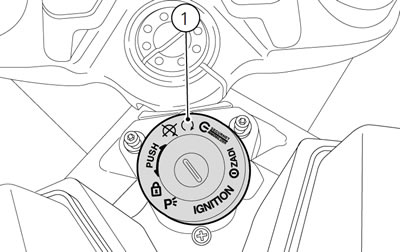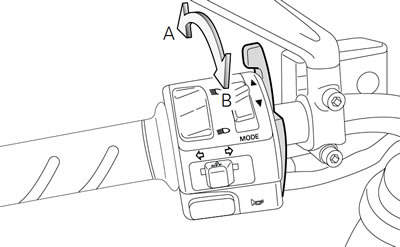Note. Follow the recommendations «High temperature air» (page here) to start a hot engine.
Attention! Become familiar with the controls before starting the engine.
Normal air temperature
(between 10°C and 35°C)

Pic. 52.
1) Turn the ignition key to position 1 (pic. 52). Check that the green indicator (N) and red indicator (
Important. The red low oil pressure indicator should go out a few seconds after the engine starts (Here).
Attention! The side support must be in the raised state, otherwise its sensor will not allow the engine to start.
Note: The engine can also be started with the side stand lowered if the gearbox is in neutral. If any gear is engaged, you must depress the clutch to start the engine (the side support must be raised).
2) Move the cold start lever to position B (pic. 54).

Pic. 54.
3) Make sure the switch «engine-stop» (2, fig. 53) is in position

Pic. 53.
Note. If the battery is very discharged, the automatic system will not turn on the engine starter.
4) Gradually move the cold start lever closer to the vertical position (A), so that the engine idle speed remains within the range of 1400 to 1500 rpm. This ensures optimal conditions for warming up the engine.
Important. Not «gas it up», while the engine is cold. Give the oil some time to warm up and reach all the points where lubrication is needed.
5) When the engine warms up, move the cold start lever to position A all the way. If the engine idle speed is adjusted correctly, it should be kept at a minimum level (about 800 rpm), maintaining smooth rotation of the motor shaft.
High air temperature
(above 35°C)
Proceed as for normal ambient temperature, but do not use the cold start lever.
Low air temperature
(below 10°С)
Follow the same steps as for normal temperature, but allow more time for the engine to warm up (up to 5 minutes).
